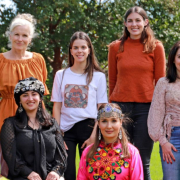Stories Sell… Here is Why
By: Michael McQueen
Storytelling is one of the hottest buzzwords of the last few years. Far from being merely a trend or fad though, the power of narrative is unrivalled in its ability to capture and maintain the attention of a listener.
From science to sociology, narrative consistently emerges as fundamental to human wiring – as a tool of persuasion, its significance is hard to overstate.
The human brain appears to be so wired for narrative that when a story is absent, we will create one in order to make sense of the world around us. Some of the pioneering work examining this dynamic was conducted by legendary Austrian psychologist Fritz Heider back in the 1940s. Heider’s research centred on showing subjects the animation of 2 simple triangles, a rectangle and a circle. With only one exception, every single research participant read an entire plot line complete with drama, love affairs and bullying into the four shapes on the page. Without a clear narrative, it is human nature to invent one.[1]
This principle is often involved identification of so-called ‘cancer clusters’ as David McRaney suggests in his book You Are Not So Smart. “If you look at a map of the United States with dots assigned to where cancer rates are highest, you will notice areas of clumping. It looks like you have a pretty good indication of where the groundwater must be poisoned, or where high-voltage power lines are bombarding people with damaging energy fields, or where phone towers are frying people’s organs, or where nuclear waste must have leaked. A map like that is a lot like the side of the sharpshooter’s barn, and presuming there must be a cause for cancer clusters is the same as drawing bull’s-eyes around them.”
As McRaney points out, these clusters rarely have any genuinely worrying environmental cause but are, instead, due to unrelated factors. “People who are related tend to live near one another. Old people tend to retire in the same areas. Eating, smoking, and exercise habits tend to be similar region to region.” McRaney acknowledges how the notion of coincidence can feel disempowering and unsatisfying. Humans long for an antagonist, an explanatory pattern or at least a causal link to help them make sense of the random nature of reality.[2]
How Conspiracy Theories Arise
Daniel Kahneman and Amos Tversky observed this same dynamic at work in London during the Blitz. After night after night of bombing raids, residents began to notice that certain neighbourhoods were consistently spared. This, they concluded, must have meant that there were German spies living in those buildings. While this popular belief seemed to make sense at the time, analysis found that the bombing strike patterns were indeed entirely random.[3]
It’s easy to see how this proclivity to storytelling, or seeing stories where there are none, can affect everything from our interpretation of coincidences to our understanding of politics.
Speaking in response to the proliferation of conspiracy theory in recent years, trend forecaster and World Economic Forum contributor Dave Mattin suggests that “Conspiracy theories won’t be defeated by reasoned argument.” He continues, “What we need, then, is an alternative story. One that lands at the same pre-rational level… Humans abhor an explanatory vacuum. Faced with an absence of convincing explanations, it’s no wonder people have made up their own.”[4]
The University of Bristol’s Stephan Lewandowsky picks up on this same theme in his compellingly titled book The Debunking Myth Handbook. According to Lewandowsky, it is not enough to simply knock down a falsehood or myth – you must create a credible alternative narrative to fill the void.[5]

While it accounts for a significant part for the rise of conspiracy theory in recent years, the human attraction to narrative can result in productive outcomes as much as it can negative. Marketers tap into it all the time. The reality is that few things grab our attention and are able to maintain it as effectively as a well-told story. For anyone aiming to hold the attention or change the mind of someone else, narrative is the most effective and most intrinsically human persuasive tool on offer.
Green and Brock suggest that the four core ingredients of a persuasive story involve foregrounding, imagery, suspense and modelling. Techniques that make the mundane seem fresh, mental pictures that enliven the words, tension that holds a listener’s interest and characters that model the journey you are attempting to exhibit are highly effective within effective storytelling.
In terms of narrative formats, there are few who get it as consistently right as the team at animation giant Pixar. According one of Pixar’s former story artists, the studio’s success in creating stories that audiences get lost in is no accident or fluke. In fact, the story arc of every Pixar movie follows a proven formula that consists of six sentences:
- Once upon a time____.
- Every day, ____.
- One day ______.
- Because of _________.
- Because of that, __________.
- Until finally _________.
Audiences are Moved by Stories
As Dan Pink observes in To Sell is Human, this simple and sequential format is persuasive because it “forces conciseness and discipline.”[6] To add to this, drawing upon existing archetypes and motifs within narrative traditions can be a great way of further empowering a story, as it becomes immediately familiar to specific audiences. Reframing stories or adapting their language to the tradition of a target audience allows the audience to connect to the story emotionally before they have even considered its message cognitively.
In the words of narrative expert Michael Margolis, “People don’t really buy a product, service, or idea; they buy the story that’s attached to it.”[7] In much the same way, your audience is unlikely to ‘buy’ your idea or point of view no matter how persuasive or logical it is. They are far more likely to be moved by the story attached to it.
To be certain, relying entirely on narrative as a tool of persuasion can be dangerous. As British physician and academic Ben Goldacre suggests, “The plural of ‘anecdote’ is not data.” And yet, narrative has a unique ability to tap into the hearts and minds of others. Better yet, good stories unlock emotion, ignite empathy and move people to act.
[1] Grave, C 2015, ‘Why Debunking Myths About Vaccines Hasn’t Convinced Dubious Parents’, Harvard Business Review, 20 February.
[2] McRaney, D 2012, You Are Not So Smart, Avery, New York, pp. 40-43.
[3] McRaney, D 2012, You Are Not So Smart, Avery, New York, pp. 40-43.
[4] Mattin, D 2020, ‘New World Same Humans #33’, New World Same Humans, 7 September.
[5] Grave, C 2015, ‘Why Debunking Myths About Vaccines Hasn’t Convinced Dubious Parents’, Harvard Business Review, 20 February.
[6] Pink, D H. 2013, To Sell Is Human, Riverhead Books, New York, pp. 171, 173.
[7] Eyal, N 2014, Hooked, Penguin, New York, p. 134.
.
Article supplied with thanks to Michael McQueen.
About the Author: Michael is a trends forecaster, business strategist and award-winning conference speaker.
Feature image: Photo by Rain Bennett on Unsplash








